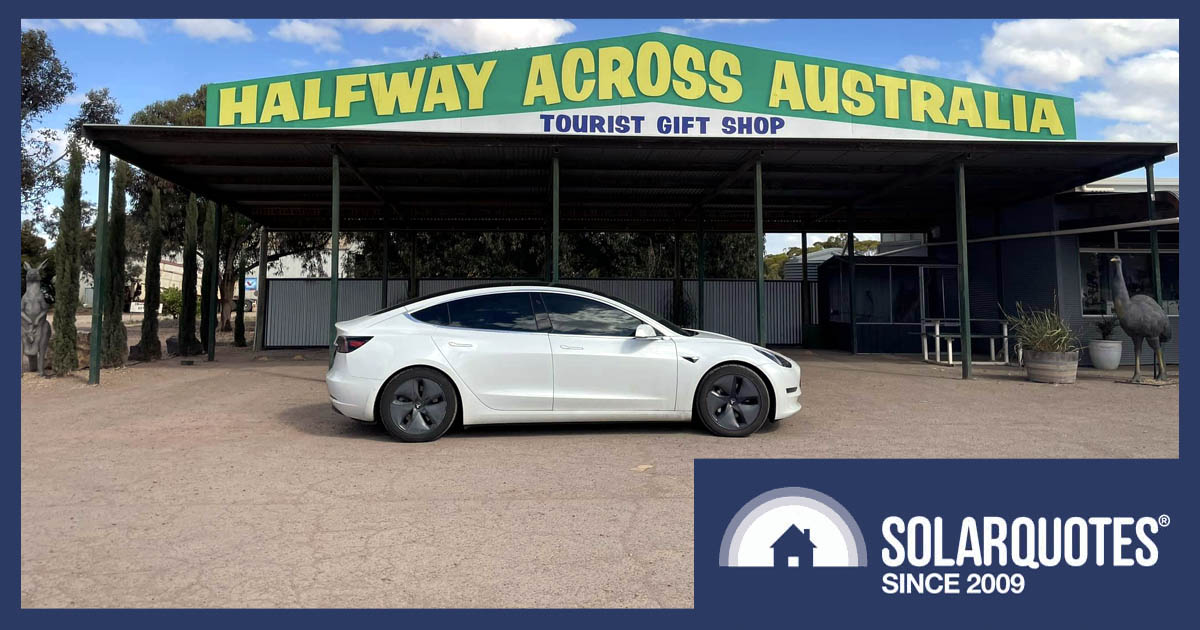
Rob and Sally needed a holiday, so they jumped in their EV and drove from Sydney to Perth – and back again. They wanted to know what the experience would be like, and thought it would be a good opportunity to show the world how easy it is to drive from the Pacific to the Indian Ocean in an electric vehicle.
The thing is, as they found out, they’re not the only ones doing it. EV sales in Australia in 2022 were up 65% from the previous year, and owners are reaping the benefits of having cheap fuel and seeking out new frontiers with their cars.
Rob and Sally are passionate renewable energy advocates. Rob runs a YouTube channel (@SydneyEV) where he talks about aspects of EV ownership, include charging, infrastructure, EV features, and dealing with range (not rage). Sally makes plenty of appearances too, and together they make a great team. We’ll undoubtedly see videos of this epic trip on the channel soon.
In the meantime, here’s an outline of their trip and their thoughts about the journey. But first, a shot of their Tesla 3 overlooking the Great Australian Bight near the WA-SA border.
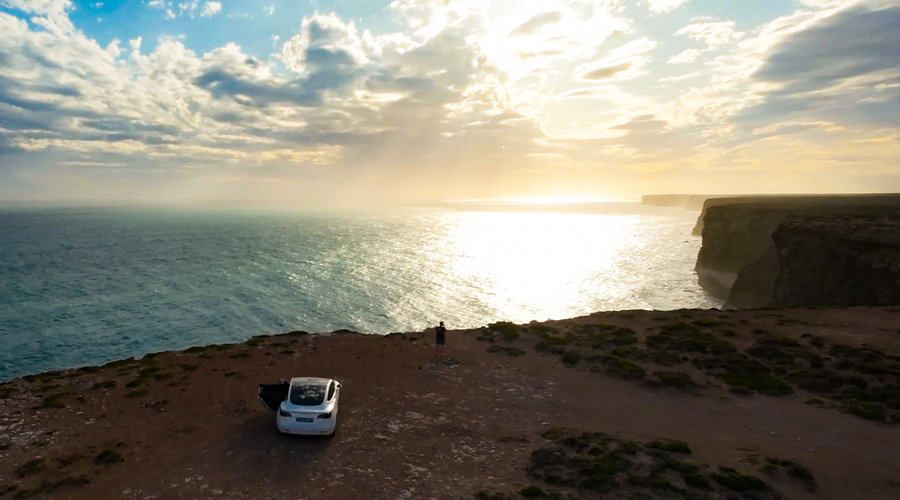
A drone shot of Rob and Sally’s Tesla 3 overlooking the Great Australian Bight near the WA-SA border.
Planning The Trip
I asked them how they managed to charge the vehicle. Did they plan the trip before they left, or just hit the road and see what happens? Rob says:
“The only part we planned was from Sydney to Broken Hill. Many of the sites on that route in the NRMA network only have one charger, so you’ve got to make sure they’re working before you go. We simply checked on PlugShare to make sure they’ve recently been used, then off we went.”
For non-EV owners – PlugShare is a website and mobile app that helps electric vehicle drivers find charging stations in their area. Users can search for charging stations by location, connector type, and availability and view reviews and photos of the stations. The PlugShare map is also available here on SQ.
Another minor detail that’s handy to know – their Tesla 3 conservatively gets 370km on a fully charged battery and about 440km around town. That’s much better than the 200km per tank I was barely scraping out of my 1972 Honda K2 motorcycle when I made the same trip.
Charging Equipment
This is a list of assorted chargers, cables, and adapters Rob and Sally took with them just in case, and whether or not they were needed:
- Standard single-phase Tesla charger (tick).
- 15A single phase extension chord (tick).
- 3-phase charger (tick).
- Standard 3 phase adaptor for above (tick).
- 32A 3-phase extension chord (not needed).
- Standard Type 2 to Type 2 extension (not needed).
- J1772 plug to Type 2 adaptor (not needed).
- 32A 3 phase to 15A single phase adaptor (not needed, thankfully) – hey guys, I’m not sure if this is legal! I can’t see any 15A overload protection on this baby!
- 10A to 15A single phase plug adaptor (not needed) – this one’s legit, complete with the appropriate sized circuit breaker.
What we took with us to #charge on the #EV #Roadtrip across the Nullarbor to #Perth. 3phase mobile charger, the OEM #Tesla mobile connector. A 15 amp extension cable and that’s pretty much all we actually used. #ausev #evcharging #power. pic.twitter.com/Y04ClbsEjl
— Sydney EV 🔋☀️ (@sydney_ev) December 22, 2022
Internet
You can’t go anywhere without the internet, right? Rob and Sally went top shelf. They purchased a Starlink kit that includes a satellite dish and modem, which gave them high-speed broadband at up to 150 Mbps anywhere on the route, even while driving.
They were able to track the car the whole way and collect data such as GPS position, average speed, average charge times, power usage, and a whole lot of other stuff they’ve yet to collate.
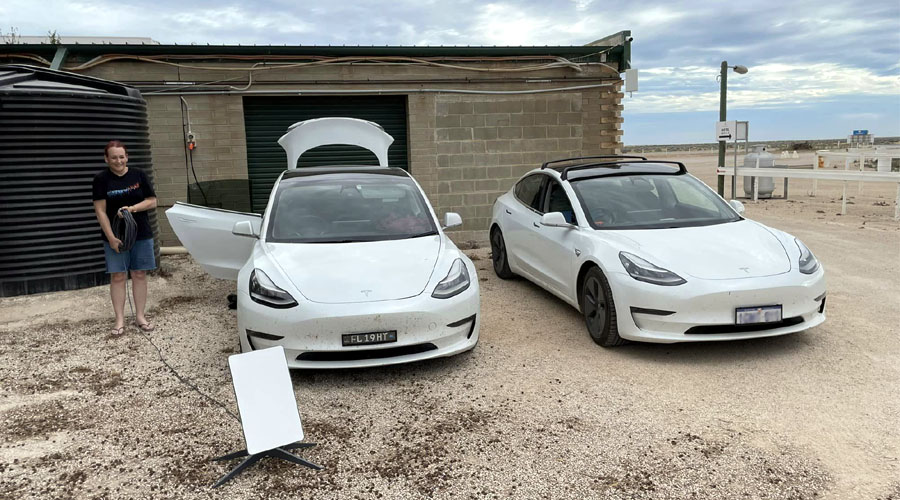
Charging at the Nullarbor Roadhouse with the Starlink dish set up, and another Tesla owner arriving on his way from Perth to Tasmania.
Road Tripping
Everybody’s doing it! Well, not everybody, but it’s more common than you’d think. They met quite a few like-minded EV owners crossing the Nullarbor. One was a Perth girl they met in Poochera, SA, who’s just finished her return trip from Perth to Sydney in a BYD Atto 3. Read about her adventures and give her a thumbs up on FaceBook – Atto Gal’s EV Adventures.
In Ceduna, another Tesla was charging at their hotel. He was heading from Brisbane to Perth. Twice Teslas pulled in to charge at Nullarbor Roadhouse on both trips there and back. On several occasions, Teslas whizzed past them, going the other way.
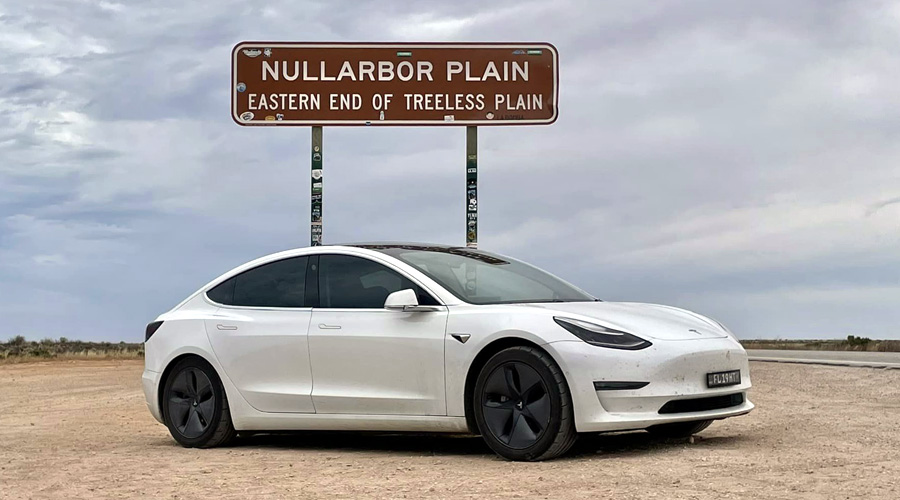
The eastern end of the famous Nullarbor Plain.
The way the rural and outback charging network is at the moment, it helps to have a casual approach for a trip like this. Enjoy the ride rather than be focused on looking at the clock: “are we there yet?”
Sally says: “As far as charging goes on the route to Perth, after Broken Hill there’s not much in the way of DC fast chargers until you hit WA. You really have to take it day by day because there’s no guarantee you’ll reach your destination at a particular time. Unfortunately, South Australia is a bit of a desert when it comes to DC fast chargers, apart from the southeast corner. The most westerly located fast charger on our route was in Clare. Other than that we had to rely on 3-phase power outlets until WA.”
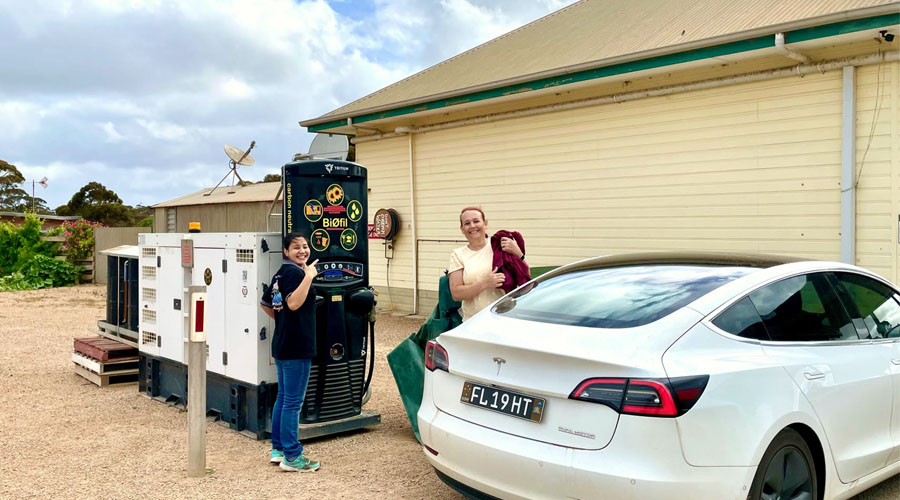
Recharging at Caiguna on 50kW DC fast charger powered by cooking oil.
Fun fact:
A 32A 3-phase outlet can charge at a rate of up to 22kW, depending on the vehicle. Rob and Sally’s Tesla will only charge at 11kW with an AC charger. DC fast chargers start at 22kW, and some can charge up to 350kW. The process is much quicker with DC chargers because they don’t have to convert (rectify) AC to DC, and so they can inject high DC current straight into the car battery.
For example, a 20kW DC fast charger can theoretically charge a 60kWh battery in 3 hours (from 0%). An AC charger will take about twice as long. You can read more about EV chargers in Finn’s EV Charging 101 Guide.
The Fuel Bill
How much did it typically cost to fill ‘er up?
“It depends. Some places have a flat fee, and some ask for a donation to the RFDS or their local bush fire service. Some will charge an hourly rate, and others by the kWh. Some hotels provide free charging with accommodation. All this information is on Plugshare and updated with prices by the active community on there,” says Sally.
The average cost of charging on a fast charger was approximately $0.40 per kWh, whereas the slow roadhouse chargers cost about $1 per kWh. The total cost of charging was $714 for the 9,630km trip, including all Tesla Superchargers and Chargefox DC fast charging.
Compare that to the average petrol car (9L/100km) with an average fuel price on their route of $1.95/litre, spending a total of around $1,700 on petrol. That’s a saving of almost 60% for the EV. Considering Rob and Sally usually charge at home with surplus solar energy for free1, things are looking good for the economics of electric vehicles.
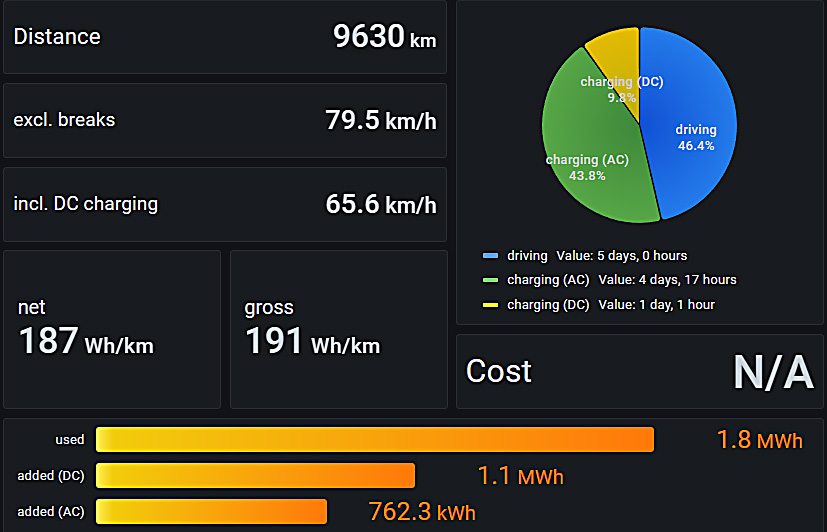
A glimpse at the energy stats for the whole 9630km trip.
Anything Learned From This Trip?
Phone Ahead!
“That way you’ll know if there’s a charger available. It’s easy. Put the route into Plugshare. It gives a list with details of all the chargers on that route with phone numbers,” says Rob. “Phone up and give them your ETA. Every place was happy to see us and very friendly.”
Charger Reliability
Forget range anxiety. That’s not really a thing for EV owners, it’s more like charger reliability anxiety.
“You don’t always know if a charger will be available or working. Reliability on the non-Tesla network is, putting it mildly, a little lacking right now. Unfortunately, this is a big problem in Australia that needs to be sorted,” says Sally.
Car Energy Management
They learned to trust the range of the vehicle and found out what it was capable of. Like a petrol vehicle, slowing down saves not only lives, but also fuel.
They pushed the envelope a bit too far for my liking, though! Rob says:
“On the return trip when leaving Madura, our destination that day was Nullarbor Roadhouse. The car told us we would arrive with -5% charge (translation: not make it!) By adjusting our speed we were able to reassess the energy demand on the go, and drove past two roadhouses (Mundrabilla and Border Village) without stopping, arriving at Nullarbor with 2% left in the tank!”
Anyone that knows this remote stretch of road would agree that they have nerves of steel!
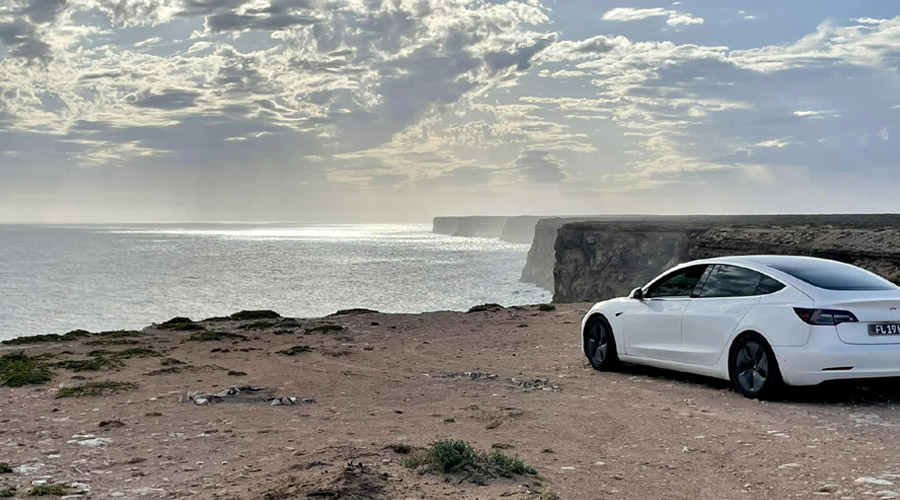
Another lookout on the WA side of the SA border.
Improvements Needed
As stated above, the number of chargers available and the reliability of the non-Tesla network are a giant roadblock to mass EV adoption in Australia right now. Fortunately, this will change, but it can’t come soon enough.
Not every potential EV buyer wants a Tesla, for whatever reason, so 3rd party chargers need to be reliable and in large numbers. Most Tesla sites have at least 4 serviceable chargers, while many towns have only one 3rd party charger, which is often broken.
Why and where the answer lies is anybody’s guess. Please weigh into the conversation with answers if you have any.
In the meantime, here’s a brief outline of Rob and Sally’s route, including distances, maps, and charging stops with charger details where possible.
The Route
GPS tracking of the whole route.
Day 1 – Sydney to Cobar (684km)
The first charge was a quick top-up at Bathurst (120kW Tesla Supercharger) while buying last-minute road snacks, then the next stop was Dubbo (120kW Tesla Supercharger), then a quick top-up at Nyngan for lunch (NRMA DC fast charger) before heading to Cobar for the night (75kW NRMA fast charger).
Day 2 – Cobar to Jamestown SA (785km)
A recharge at Wilcannia (75kW NRMA fast charger), then to Broken Hill (50kW NRMA fast charger), and arrive at Jamestown staying overnight with free charging at Jamestown Railway Hotel (Tesla 22kW charger).
Day 3 – Jamestown to Ceduna (597km)
A five-hour recharge at midday in Kimba (32A 3 phase outlet – $50 donation to RFDS). Arrived at Ceduna with an overnight free recharge at the Motel (11kW Destination Charger).
Day 4 – Ceduna to Mundrabilla WA (580km)
Lunch and a recharge at Nullarbor Roadhouse for 5 hours (32A 3 phase outlet – $50 donation to RFDS) before arriving for an overnight free recharge at Mundrabilla Roadhouse (32A 3 phase outlet – free with accommodation).
Day 5 – Mundrabilla to Norseman (621km)
Recharge at Madura Pass Roadhouse for 2 hours (22kW CCS2 DC charger – $20 donation), then another stop at Balladonia for 1.5 hours (22kw CCS2 DC charger – $1 per kWh), arriving at Norseman Caravan park for overnight slow charging on a 15A single phase outlet.
Day 6 – Norseman to Jerramungup (470km)
Charged at Esperance Country Comfort Motel for 2 hours while doing laundry for a $10 fee (11kW Destination Charger) before heading to Ravensthorpe for a recharge (11kW Tesla Destination charger), then overnight at Jerramungup Caravan park (22kWDC fast charger).
Day 7 – Jerramungup to Perth (441km)
One 10-minute stop at Williams (250kW Tesla Supercharger), then spent a day in Perth before heading to Bunbury (Chargefox 50kW RAC Electric Highway network – 45c/kWh).
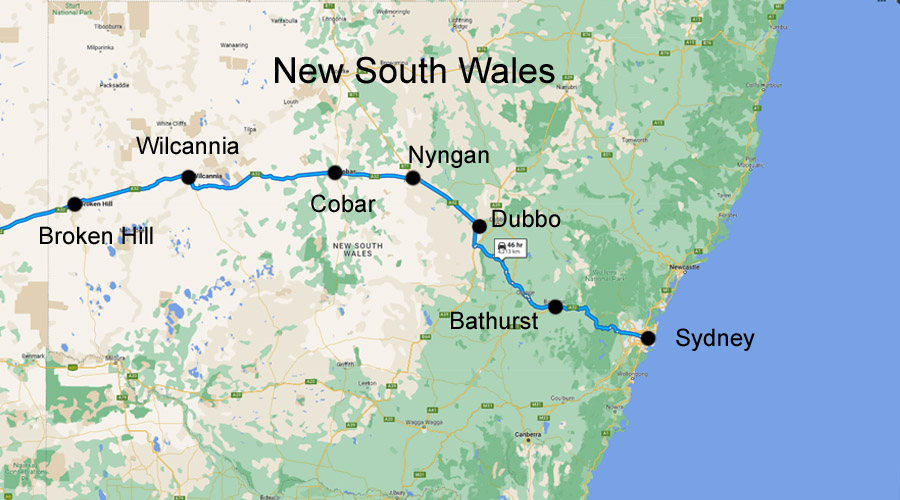
NSW charging stops east to west.
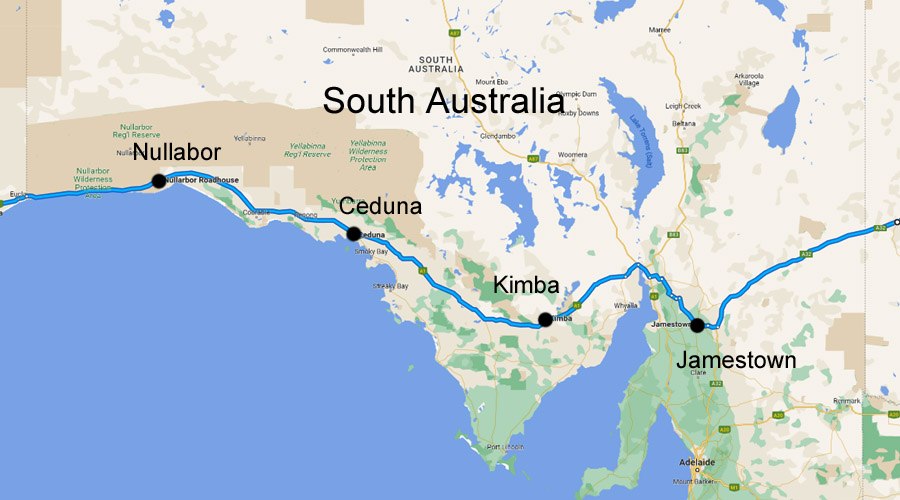
SA charging stops east to west.
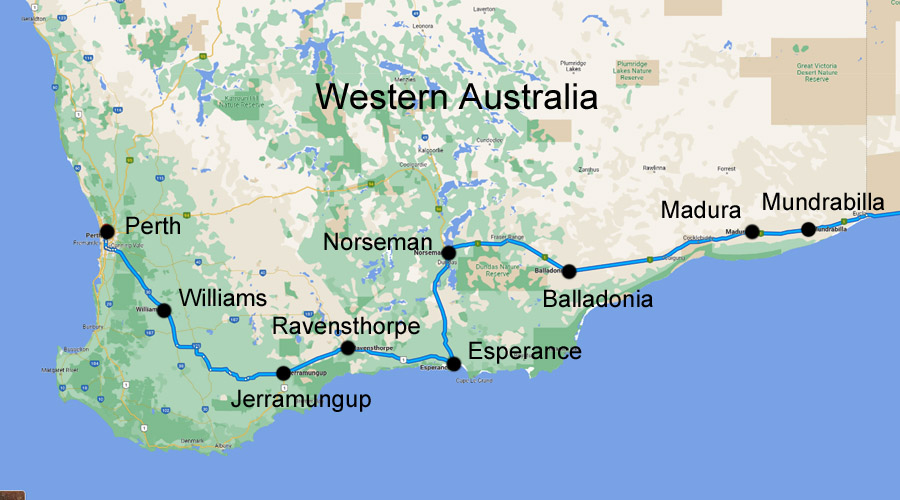
WA charging stops east to west.
Return Trip
Day 8 – Bunbury to Augusta (145km)
Travelling via Margaret River, then overnight stay at Augusta (Chargefox 50kW RAC Electric Highway network – 45c/kWh).
Day 9 – Augusta to Lake Grace (409km)
Overnight stay at Lake Grace (Chargefox 50kW – public donation for the Perth to Esperance Electric Vehicle Highway).
Day 10 – Lake Grace to Norseman (400km)
Travelling via Hyden with a midday charge at Hyden Roadhouse for 2 hours (32A 3 phase outlet – 40c/kWh), then a dirt road to Norseman and an overnight stay at the caravan park again (15A single phase outlet).
Day 11 – Norseman to Caiguna Roadhouse (372km)
Recharge at Caiguna on a 50kW DC fast charger powered by cooking oil. Overnight camping ($50 flat fee).
Day 12 – Caiguna to Nullarbor Roadhouse (534km)
Topped up at Madura (22kW CCS2 DC charger – $10/hr donation to RFDS). Leaving Madura with an estimated -5% on arrival, passed Mundrabilla and Border village chargers as reducing speed to 90Kmph increased the car’s range. Arrived at Nullarbor roadhouse with 2% remaining in the battery. Charged overnight at Nullarbor Roadhouse again (32A 3-phase outlet – $50 donation to RFDS).
Day 13 – Nullarbor Roadhouse to Ceduna (297km)
Left at 5:30 am as another EV driver arrived from Melbourne on the way to Perth at 5 am. Arrived at Ceduna mid-morning, relaxed in town with a free overnight recharge at Ceduna Motel (22kW Tesla Destination charger).
Day 14 – Ceduna to Port Augusta (469km)
Mid-way charge at Poochera Hotel (32A 3 phase outlet – $20 fee). The hotel owner wants to install fast chargers as now many EV drivers arrive to charge, and the local petrol station has closed down. Overnight charge at Port Augusta (11kW Destination Charger).
Day 15 – Day trip Port Augusta to Woomera return (362km)
Overnight stay at the same motel in Port Augusta and a recharge (11kW Destination Charger).
Day 16 – Port Augusta to Horsham VIC (736km)
Charge at Clare Valley Supercharger (150kW Tesla Supercharger – 51c/kWh), then at Keith (Chargefox 100-350kW DC fast charger), and on to Horsham for an overnight stay and charge (type 2 charger).
Day 17 – Horsham to Sydney (1060km)
13.5 hours total trip time, including charging at Bendigo (120kW Tesla Supercharger), Euroa (120kW Tesla Supercharger), Albury (120kW Tesla Supercharger), Gundagai (120kW Tesla Supercharger), Goulburn (120kW Tesla Supercharger), then home to Sydney.
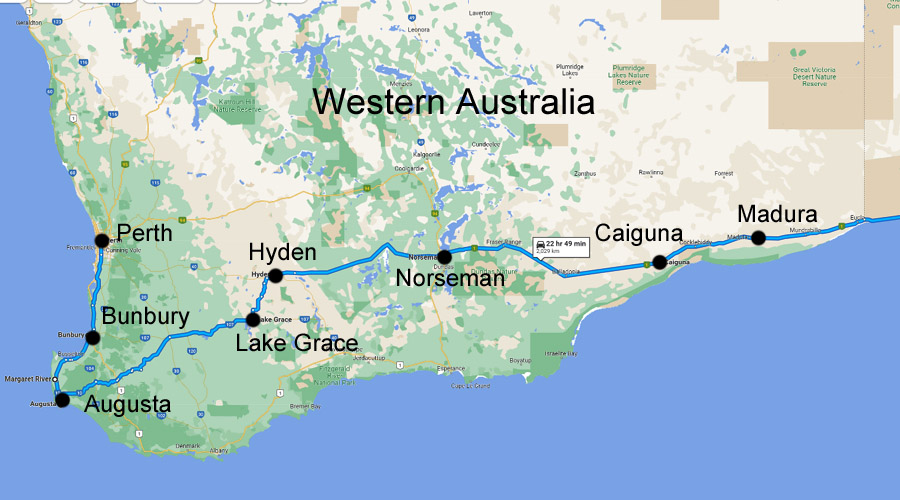
WA charging stops west to east.
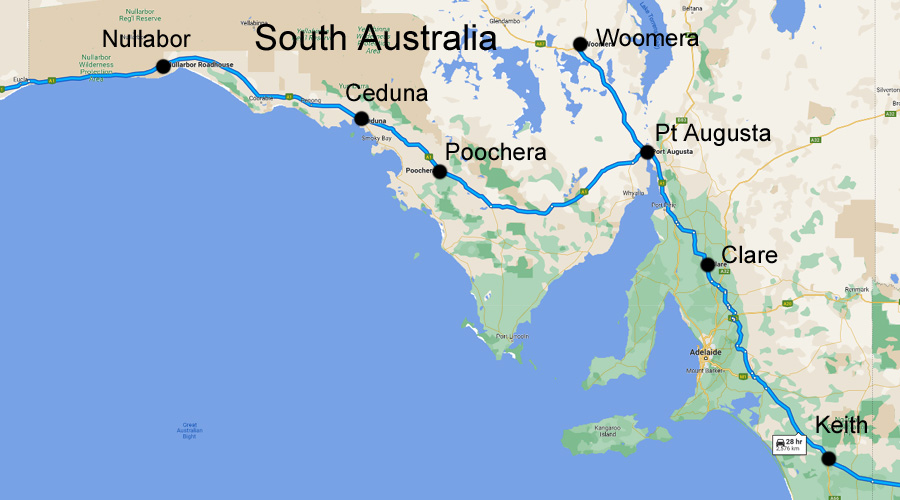
SA charging stops west to east.
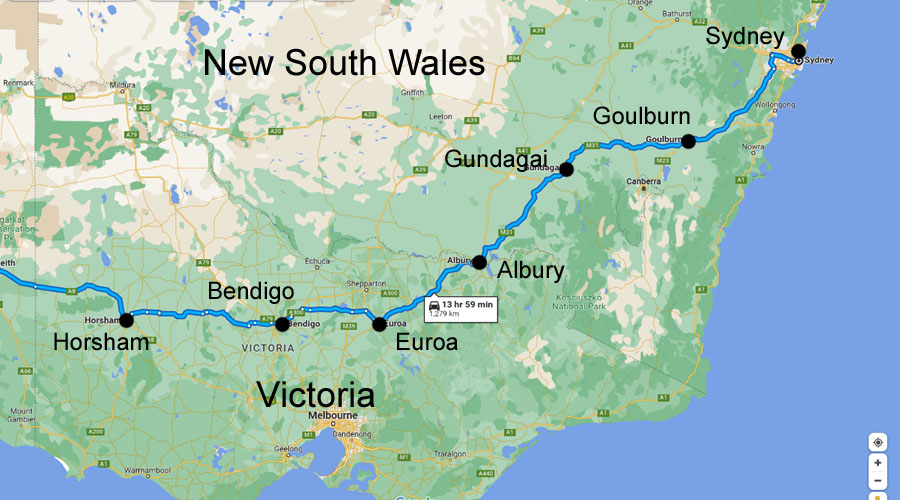
Vic and NSW charging stops west to east.
What Are You Waiting For?
Jump in your EV and get on out there and explore the world!
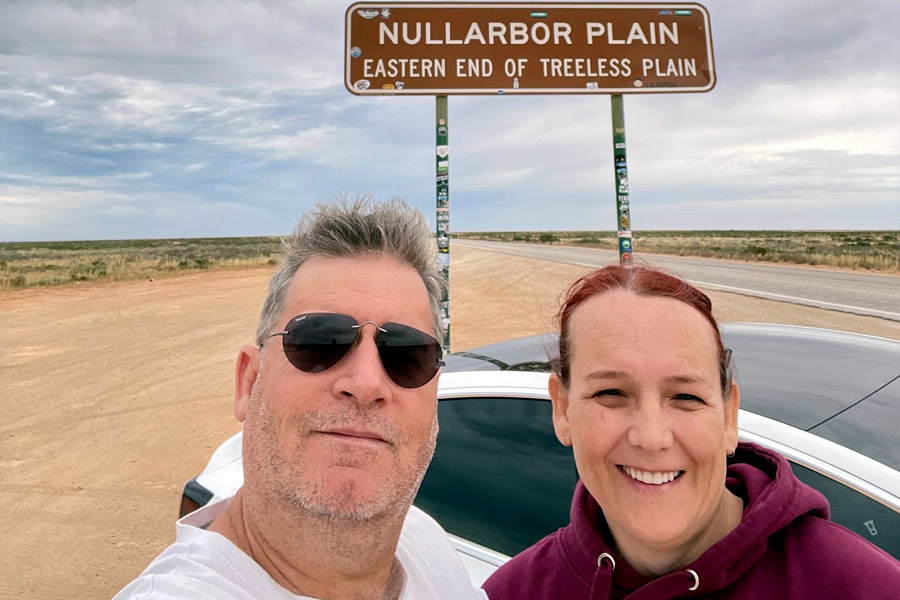
Obligatory selfie at the most famous landmark in this article.
Footnotes
- Using excess solar to charge an EV is not normally free, because you have to account for the relinquished feed-in tariff you would have otherwise received. ↩

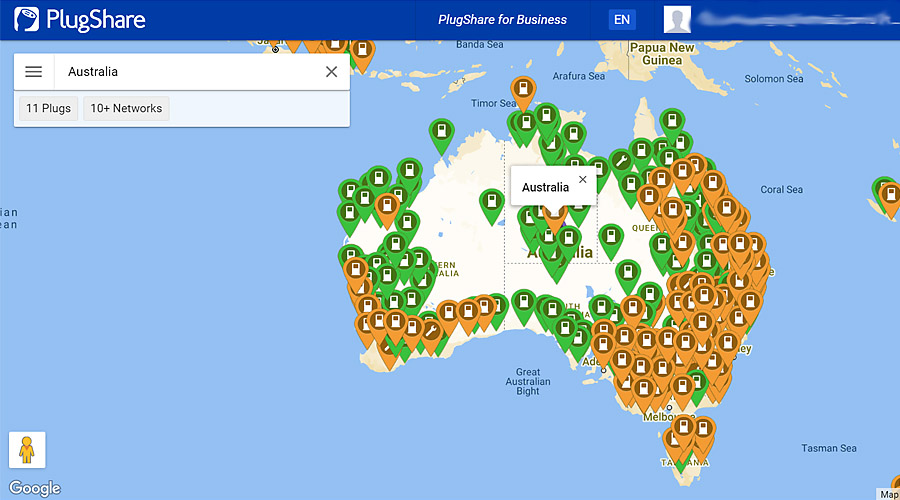
 RSS - Posts
RSS - Posts



“Using excess solar to charge an EV is not normally free, because you have to account for the relinquished feed-in tariff you would have otherwise received.”
Although if you’re export limited (we are at 5kW) and you’ve got 8kW available, you can run the house, put 2.2 in the car and still get the feed-in.
Correct! Export limiting is one exception.
Hence “is not normally free” 🙂
Nice to see the trip well documented with real figures. My question would be what speed were they cruising on on the longer stretches and did they use the vehicle AC much?
I’d like to know that too Ian. I’ll handball across to Rob and Sally, then come back to you.
hello, we travelled at highway and signposted speed limits for most of the trip, even the long legs, the only legs we slowed down were from Hyden to Norseman, which was corrugated dirt road, and being in a low performance vehicle, was more to save suspension, better ride and less chance of damage.
The other leg, from Madura Pass to Nullarbor Roadhouse, we slowed to 90Kph to preserve range, as we were driving into an average 20kph headwind. we stretched the initial car estimate of arriving with -5% to arriving with 2% remaining, without the headwind component, we would have bene ok at the posted limit.
Rob.
Thanks for clearing up my question.
Thank you for the insight into Ev long distance driving. However you did not answer the question ask about using the air conditioning and how it affects the range or not
hello, for most of the trip, we were driving at the posted speed limit, the only times were driving slower, were the Hyden to Norseman leg, and that was due to the road being dirt and corrugated, so we reduced speed to improve the ride, and prevent damage to the car is it’s a performance vehicle, not really suited to long dirt road trips.
The other long leg we had to slow on was from Madura Roadhouse to Nullarbor Roadhouse, the car estimated arriving with -5%, and with a constant headwind of 20kph and occasional showers, we reduced speed to 90kph, and the range estimation eventually rose, and we arrived with 2% remaining.
If there was no headwind, I’m confident we could have made it easily driving at the posted speed limit.
Your article regarding Rob and Sally’s cross Australia EV trip made a very interesting read but, in reality does give a somewhat unrealistic comparison between EV and ICE for country travel.
When it comes to comparison fuel costs every EV article seems to give ICE figures which relate to a V8 Toyota Land-cruiser Sahara, or similar, which is not a realistic comparison!
My Honda Civic Hatch is a similar sized vehicle to a Tesla model 3 and is a more realistic comparison. Unfortunately I can’t include a photo here to verify what I am saying but, my Civic hatch set on economy mode and country driving will give just over 900 Kms from a 44 litre fuel tank. In fact if I don’t use cruise control I can almost get 1,000 Kms from a full tank. Last time I came back to the Adelaide Hills from Sydney I filled up at a place called Collingullie, 20 Kms west of Wagga Wagga on the Sturt Highway which is 960 Kms from Adelaide. That tank full got me back home to Mt Barker.
Now using Rob and Sally’s figures, they did 9,630 Kms and it cost them $714. Using an average price of $1.80 pr litre I would need 10 tanks fulls of unleaded 91 fuel to do that same distance at a cost of $80 per tank-full…….$800 all up so, there is essentially no cost saving in driving a Tesla EV across Australia than driving my Honda Civic, and I certainly don’t have the hassle of trying to ‘lucky dip’ it for a charging station every few hundred Kms. Most of us have the ability to take cheap fuel in the form of a jerry-can with us, which, for me almost covers the trip without a fuel stop! I very rarely pay more than $1.60 pr lte for fuel which would make my cost for than 9,630 Kms about the same as Rob and Sally’s.
This is why these cost comparisons annoy me…..we don’t all drive Toyota Land-cruisers or Nissan Patrols and for my money the additional cost to purchase an EV will never be recouped in running cost savings.
The comparison is not realistic, compare Apples with Apples.
Cheers……..Rob
hello, no one expects to travel for free, even in an EV, but the biggest consideration which makes a significant reduction in cost, is the time you are not on a roundtrip, we have over 110,000km on the car now, and 90,000km of that has been charged at home, from excess solar, or free charging in the local shopping centre carparks. so, for most of the time the car is doing the regular commute, you are charging at rates that are either, lost solar export revenue, say around $0.10kw or off-peak rates.
We are not really comparing anything here, just stating what the trip entailed, and the costs involved, you could compare that to anything you like, if you really wanted to save money and time, book a plane ticket. the main point of the trip, other than, enjoying a long road trip holiday to explore places we have never been, is to show that with a little planning, like every other holiday, trips almost anywhere are easily achievable, in an EV.
Rob…..or Sally, I am trying to justify the cost of an EV, and for round city use with rooftop solar it makes a lot of sense. On a good summer time day I can produce 52 Kws of solar which the power companies literally steal from me. In the winter I am in solar negative territory!
But having my family on the East coast I make that trip from the Adelaide hills to Sydney and the central coast 4 times a year, and from what I am seeing, EV charging is something of a shambles…..and I don’t think it is going to get any better. As EV vehicles become more popular the government is missing out on fuel tax revenue so, it is inevitable that they will do the same as they have with rooftop solar they will progressively introduce a tax on EV charging to offset the loss of that road maintenance tax that the fuel excise covers. The cost of charging at EV stations is going to rise at a disproportionate rate so I can’t see that it is ever going to become viable for country traveling.
For my situation owning an EV is never going to become viable!
Cheers……..Rob
The lost fuel excise revenue will be replaced by a road distance tax, as is already in place in VIC and coming to NSW and other stated in a few years, but yes, at the moment, NON-Tesla EV charging is unreliable and needs to be fixed, A trip from the Adelaide Hills to Sydney is doable in the areas covered by DC fast charging, We managed the distance from Cobar to Jamestown using the 50Kw DC network, and covered that in a single day, but the reality is at the moment, those towns along the way are serviced by a single charger, and if it has failed, then you’re stuck with a lot longer charge of a few hours using 3 phase 11Kw.
Every town has a showground and charging can be don’t there if desperate. but yes, it needs to be fixed, and can be alleviated with more installations.
so, if one charger has failed, there might be 5 or so others to choose from. but that hasn’t happened yet and will take some to time to rollout.
Hi Robin
52 kilowatt-seconds (kWs) is not very much energy at all (0.0144 kWh).
Did you mean 52 kWh – which is a good total day’s energy production for a home rooftop Solar system in mid-Summer (but, I guess you might wish to use some of this to run your home – so that Mr DNSP doesn’t ‘steal’ it from you!)? I’d get nothing like that in Winter from my system.
I suspect I’m not the sort of person to take regular 5 hour lunch breaks – so would probably condense the 17 day experience into ~6-8 days travelling using an ICE for now. Or fly… I agree with you that we shouldn’t be comparing EVs with V8 Landcruisers – my 10 year old full-size sedan (bigger than a Model 3) gets 6L/100km or somewhat better when cruising at 110 km/h!
Hi Ian, If you re-read my post I didn’t say anything about Kw seconds!! What I said was “On a good summer time day I can produce 52 Kws of solar which the power companies literally steal from me”. I have 2 rooftop systems one of which Finn Peacock helped me greatly with.
I have a 2Kw system which was installed prior to September 2011 and I have augmented that with another 5kWh system which was installed in Sep 2019.
The output from both of these systems combined will achieve up to 52kWh (note Ian, nothing about seconds) on a sunny day in the middle of summer.
By adding to my existing 2 Kw system I lost the guaranteed feed-in tariff I was achieving and am actually worse off in the summer than I was. My feed-in tariff has now dropped from 50c pr Kw to 5c per kWh.
I wish you all the best Ian but please read the post properly before making critical comment on it!
Cheers…….Rob
There has been some confusion with units. I’m sure you were referring to kilowatt-hours (kWh), Robin, so I have updated your above comment but left your previous one as it was.
Robin Shannon,
“I very rarely pay more than $1.60 pr lte for fuel…”
When did you last put fuel in your tank at or below that price, Robin?
Per FuelPrice Australia, the last time retail Unleaded 91 petrol averaged at or below $1.60 per litre at Mt Barker was apparently on 25 Sep 2022.
https://fuelprice.io/sa/mount-barker-2/
Per the Australian Institute of Petroleum, average weekly retail prices for ULP in Adelaide have risen from a recent low of $1.638 per litre (week-ending Jan 15) to $1.960 per litre (w/e Feb 5)
https://aip.com.au/pricing/ULP/SA/Adelaide
“Most of us have the ability to take cheap fuel in the form of a jerry-can with us, which, for me almost covers the trip without a fuel stop!”
Robin, what makes you think petroleum fuels will remain affordable and abundant in Australia in the coming years?
https://www.solarquotes.com.au/blog/ev-uptake-australia-mb2822/#comment-1526016
Hi Geoff, I only ever buy fuel at the bottom of the retail pricing cycle, and on a monthly basis unleaded 91 will be available in Mt Barker for somewhere between $1.61- $1.63, and with the Woolworth 4c pr lte discount docket this means I pay somewhere between $1,57 and $1,59 pr lte.
Before the federal government ended the fuel excise rebate at the end of September I purchased 160 Lte of fuel at $1.43 pr lte and that kept me going for almost 4 months.
Geoff, I don’t chase discounts, but I do use ‘Petrol Spy’ and as a matter of principal I will never buy fuel at the high end of the price cycle. I don’t support those who choose to shaft us consumers.
In 2 weeks I am driving to Sydney again, when I leave here I will have a full tank, plus 30lte in cans, all of which I will buy for less than $1.60. That Goeff will get me to the Wyong on the NSW central coast. It’s amazing how it adds up over the coarse of a year!
Cheers…….Rob
Robin Shannon,
“In 2 weeks I am driving to Sydney again, when I leave here I will have a full tank, plus 30lte in cans, all of which I will buy for less than $1.60.”
Ah, a supreme optimist! ?
Today’s (Feb 11) cheapest retail ULP 91 fuel is at 167.9 cents/litre in the Mt Barker area.
https://fuelprice.io/sa/mount-barker-2/?fuel_type=ulp91
Or for approximately a 60 km round trip today (from Mt Barker) the cheapest retail ULP 91 in the greater Adelaide area is at 165.5 cents/litre.
https://fuelprice.io/sa/adelaide/?fuel_type=ulp91
The cheapest E10 fuel today in the greater Adelaide area is also at 165.5 cents/litre.
https://fuelprice.io/sa/adelaide/?fuel_type=e10
Looks to me like the bottom of the fuel price cycle for the greater Adelaide area is likely within the next few days. I doubt the price will get below 160 cents/litre in this cycle. We’ll see soon!
“That Goeff will get me to the Wyong on the NSW central coast.”
And what will you likely pay for fuel for your return journey, Robin?
https://fuelprice.io/nsw/sydney/
https://fuelprice.io/nsw/wyong/
I’d suggest 160 cents/litre or cheaper for petrol in Australia will soon be a distant memory. Enjoy while you can! Safe journey.
Wow Geoff you do believe in splitting straws don’t you!
Within the next 3 days I can assure you the price of unleaded petrol in Mt Barker will be around $1.63 pr lte! That will be the bottom of the fuel pricing cycle. That is when I will fill my vehicle tank and fill one of my Jerry cans. With my Woolworths discount fuel voucher which gives me a 4c pr litre discount I will pay $1.59 per litre.
Geoff, stop trying to re-invent the wheel, this is the reality of fuel pricing in South Australia. As I have said previously, I will travel from Mt Barker to the Central coast of NSW not paying any more than $1.59c pr Litre.
Can you please just accept that instead of putting up all this nonsense that is of no relevance to my actual situation…..I am serious!
Cheers…….Rob
I’m quite surprised you wish to ‘push’ the fuel cost argument, but seem to have totally forgotten the CO2 emissions angle, Geoffrey.
Using a diesel IC engine, Geoffrey, to charge an EV at certain points. Inefficiency of the diesel engine, added to losses in the alternator, plus charger losses, battery round-trip losses, inverter losses, electric motor losses, gearbox losses! All the disadvantage of an ICE, with added EV losses! And, I doubt the diesel would be running at optimum power all of the time (charging ‘throttles back’ over time).
Plus of course, regular charging overnight (no PV), which unless wind power is so sufficient that otherwise ‘spilled’ (i.e., wasted, curtailed) wind power is adequate, means that the EV is adding to the fossil fuel demand on the grid.
I’d think an efficient modern IC engined vehicle of similar size would run rings around the EV option in this case, on the basis of lower CO2 emissions.
Robin, sorry – I was being a bit ‘tongue-in-cheek’. Hopefully you now understand your ‘Kws’ would normally be written kWs, and would be interpreted as kilowatt-seconds. kW is a power term, not energy…
Ian Thompson,
“I’m quite surprised you wish to ‘push’ the fuel cost argument, … Geoffrey.”
Really, Ian? I’ve been banging on about declining petroleum fuel supplies & rising fuel costs for a while at this blog. Have you been asleep, Ian? ?
Last year: https://www.solarquotes.com.au/blog/fuel-efficiency-australia-mb2601/#comment-1490626
Last week: https://www.solarquotes.com.au/blog/ev-uptake-australia-mb2822/#comment-1526016
It seems to me you are also unable to comprehend the possibility of the era of abundant & affordable petroleum fuels ending within your lifetime. It just doesn’t compute because you’ve never experienced it (like perhaps many others who it seems to me are also in denial & refuse to accept the accumulating warning signs).
“Plus of course, regular charging overnight (no PV), which unless wind power is so sufficient that otherwise ‘spilled’ (i.e., wasted, curtailed) wind power is adequate, means that the EV is adding to the fossil fuel demand on the grid.”
Nope. Evidence/data indicates renewables are trending to be the dominant global electricity source in the next few years.
https://www.solarquotes.com.au/blog/european-electricity-review-mb2812/#comment-1524506
“Using a diesel IC engine, Geoffrey, to charge an EV at certain points.”
With increasing diesel fuel prices, I’d suggest the days of diesel-powered gensets supplying electricity for EV chargers anywhere are numbered.
“I’d think an efficient modern IC engined vehicle of similar size would run rings around the EV option in this case, on the basis of lower CO2 emissions.”
It seems you are wrong, aye Ian?
https://www.reuters.com/business/autos-transportation/lifetime-carbon-emissions-electric-vehicles-vs-gasoline-cars-2021-06-29/
https://www.iea.org/data-and-statistics/charts/comparative-life-cycle-greenhouse-gas-emissions-of-a-mid-size-bev-and-ice-vehicle
Geoff, I’m much more optimistic about oil prices not going through the roof while the world transitions to electric road transport. But if I’m wrong, then Finn’s insane bicycle repair skills will probably make him King of Adelaide.
Ronald Brakels,
“Geoff, I’m much more optimistic about oil prices not going through the roof while the world transitions to electric road transport.”
Do you have evidence/data/analysis to support your optimism, or is it just wishful thinking, Ronald?
I’d suggest the transition of Australia’s vehicle fleet could take decades. Even if Australia achieved 99% EV sales by 2030, at that pace, there would still be around 80% of Australia’s vehicle fleet still requiring petroleum fuels for ongoing operations.
https://twitter.com/tomdquinn/status/1541635198148046849
What will the prices of petroleum fuels (especially diesel, but also petrol) be in 2030 to operate Australia’s perhaps more than 15 million remaining ICEVs? $5/litre? $10/litre? $20/litre?
Would there still be enough petroleum fuel supplies in Australia (& the rest of the world) to meet demand in the coming years while the transition progresses? Perhaps not – reading the “Oil Market” section (& an accumulation of other data) does not inspire optimism in me – see at: https://blog.gorozen.com/blog/market-overview-q3-2022
Ronald, perhaps you could present evidence/data in a post (or two) that supports your stated optimism?
I lack the energy to give all my reasons for optimism — and admittedly some of it may be from being dropped on my head as a baby anyway — but I’ll give one reason, which is the banality of evil.
I’m pretty sure petrol prices will be below $3.20 a litre in 2030 in today’s money. This is because that price would represent a doubling of the price of oil. That’s enough to cause real suffering in poor countries, including hunger due to higher fertilizer and transport costs. Australians, being among the richest people in the world, will suffer relatively mild inconvenience while poor people will be forced to reduce their oil consumption and bear the real pain. This will free up oil for us to use to drive down to the Tailem Bend Speedway and watch cars drive in circles. It’s like how the failure of the Basslink increased blackouts in Manilla as diesel generators were shipped from Phillippines to Tasmania.
Ronald Brakels,
“I’m pretty sure petrol prices will be below $3.20 a litre in 2030 in today’s money. This is because that price would represent a doubling of the price of oil.”
I’d suggest you should read Wood Mackenzie’s latest piece titled Scraping the barrel: Is the world running out of high-quality oil and gas?
The graphs titled:
* Proven oil supply (developed fields only with no investment) versus demand, and
* Most likely oil supply from known fields (including undeveloped) versus demand
…IMO are telling. Same for the gas graphs. I’m not surprised.
https://www.woodmac.com/horizons/shortage-of-quality-oil-and-gas/
But it’s fanciful to think we/humanity could still be burning oil & gas in vast quantities into the 2030s & 2040s and expect to continue to have a planet compatible with maintaining civilisation into the second half of this century and beyond.
http://www.climatecodered.org/2023/02/faster-higher-hotter-what-we-learned.html
I’d suggest the Wood Mackenzie piece also ignores the IEA’s call for no new fossil fuel projects:
https://www.iea.org/news/pathway-to-critical-and-formidable-goal-of-net-zero-emissions-by-2050-is-narrow-but-brings-huge-benefits
So, Geoffrey – good to see someone has at last described a pathway (to net zero emissions)!
However, your IEA link describes this pathway as ‘narrow critical, and formidable’, and speaks of ‘critical materials’, installing PV and Wind at 4 times the rate of the record levels set in 2020. Sounds like a ‘long-shot’ to me.
Also states that nuclear will need to produce 27% of the renewable energy requirements in 2050 – something that you continue to delay and oppose. Just in case you are confused, 90% x (100% – 70%) = 27%.
We also will need REMARKABLE improvements in energy efficiency!
Given the INCREDIBLE requirements demanded by this proposed pathway, I suspect your opposition to nuclear may well be signalling a total failure of timely decarbonisation…
PV installations in 2022 were double what they were in 2020. Bonkers, I know, but good bonkers.
Bonkers yes, Ronald – but I suspect your comment is a little parochial – based solely on Australia’s experience, and perhaps from a low base.
I understand Australia’s PV installations were 7.5GW per year, linear, from 2020.
But the IEC’s pathway calls for 630GW of installations worldwide per year by 2030, just 7 years away. As the report says, equivalent to the installation of the largest solar farm presently in the whole World, PER DAY.
All hands to the pumps, guys.
Funny – I recall posting on this site pretty-much the same requirements, from calculations from first principles, more than a year ago.
268GW of solar panels were installed last year, a 45% increase from the year before. This year it’s estimated to be 315GW. So that’s halfway to the 630GW figure. If growth continues at the average of the past 20 years that amount will be exceeded by a lot.
Hm-mm Ronald – your figures suggest investments in PV are expected to drop from 45% last year, to only 17.5% expected this year (315/268 -1)…!
So, you ‘IF’ may be a mighty big one. Especially if investment increases continue to plummet.
But I do agree that IF annual increases can be maintained at 17.5% extra each year, then the 630GW annual installation target can be met by 2030 (315*1.175^6 > 630). Part of the IF being that supplies of critical materials and manufacturing capacity can keep pace with this geometrical increase – then manufacture replacements at panels age.
Hi Rob and Sally,
I intend to get an EV when they become more affordable. One thing that annoys me is that EV owners tend to guild the Lilly a bit too much. Your costs are an example. An equivalent ICE should use between 6 and 7 l/100km for your trip (my 12 year old hatchback with 270,000 km will still do approx. 4.6 l/100km on a trip). When you add the distance levy that most states are talking about of usually 2.5c/km the costs are so close as to not be a factor. Also the maintenance costs of ICE’s are generally exaggerated. My experience of Japanese and Korean vehicles is that it is rare to have an expensive surprise.
When the warranty increases and the price decrease I’ll be lining up.
Thanks for the interesting and well documented article.
Cheers Bob
Hi Bob, In Rob and Sally’s defense, it was me who threw those numbers out there. You have a point. We all drive different vehicles, however even if we use the figure of between 6 and 7 litres/100km for fuel the trip is still twice as expensive for an ICE as an EV. Also my figure of an average $1.95/ litre is actually way under for that route, so I was being kind to ICE owners on that one. But wait, there’s more – an ICE vehicle would need an extra oil change after a trip like that in addition to the regular yearly service. Add at least another $200 to the bill. I’m in the same boat as you. I can’t afford an EV but want one. This article is not about the economics of EV vs ICE but it will be coming! There’s no definitive answer on total cost of ownership for EV vs ICE at the moment because it’s early days and we all have different needs. I’m keen to explore this subject a bit further so watch this space!
yes, and to add, the savings add up on your regular weekday use, especially with a solar system, when you are recharging at a far cheaper rate, usually off peak, or at the lost feed in tariff rate. so for the Km you are doing, when not road tripping, the costs work out a lot better.
Before it was discontinued, the Australian Bureau of Statistics’ (ABS) release on fuel consumption showed that in 2020, passenger vehicles in Australia used 11.1L/100km on average. Motorcycles used fuel at roughly half this rate, averaging 6.1L/100km.
Yes Finn – but the average age of the Australian passenger car fleet is close to 10 years – and the ABS figures include data from largely city use and includes 15-year-old+ V8 gas gusselers.
I think if we are to be guenuine about fuel consumption comparisons, we should be comparing apples with apples.
For example, my 11-year-old 180kW ICE petrol automatic-transmission family sedan (about of average fleet age) ROUTINELY achieves better than 6 L/100km on long road trips at 110km/hr – probably a little faster than much of what Rob & Sally were doing, except in WA, or while trying to stretch out fuel stops. Range typically exceeds 1100km on longer road trips.
A diesel would likely do better.
Let’s hope Rob and Sally do not feel discouraged on the basis of much of this commentary. We need to hear about the experiences of the early adopters. Sure the travel time was longer than for an ICE but that is changing at least outside SA as DC fast chargers are springing up like weeds along the highways.
The use of diesel or other fuels to provide recharging facilities is regrettable but will be part of a transition to renewables.
I am encouraged by the price war in the EV area where Tesla has recently made serious reductions. Surely this is much better than government EV subsidies which often just increase manufacturers profits.
Hopefully the price of Powerwalls will also fall in due course and Finn will be able to celebrate the cost per kWh of battery power becoming competitive gor most users.
Yes, every new DC fast charger make long distance travel a lot easier, we decided to do the trip now, while it was still somewhat of a challenge.
As you can see, once back in the eastern states, our travel distances per day were a lot higher, with the last day of 1060km covered in just over 13 hours. including all charging stops, even in a petrol car non-stop, you would still take around 11 hours. the extra charge time is great for reducing fatigue. and doesn’t add significantly to trip times.
On road trips the costs might be close to a very economical car price, but the real savings are made in your daily use commuting, shopping etc, with charging from home, either off peak rates or from solar for the 90% of the distance you travel.
The charging costs on this particular trip are higher than the costs on a road trip using fast chargers, as the fees charged by remote roadhouses is significantly higher.
I was quoted $3000 dollars to insure a electric vehicle (full comp insurance) put me off electric vehicles even though we have a 56 kilowatt 3phase solar system with 3 Tesla batteries and only receive the lousy 5.2 cent export rate, so now they are going to tax the export as well, time to go completely off grid . Cheers Rob G
Hi,
Probably won’t affect us, but I’d like to see drive through charging points for people who tow caravans, boats, etc. I’m sure ScoMo was wrong about Evs ruining the weekend, and want to be sure he’s never proven right!!
Maybe one day caravan parks will start installing EV chargers too, as well as servos & shopping centres (the latter are a pain with a caravan at the best of times).
b0b
yes, very few Tesla chargers do have a spot you can plug in while towing something, sadly, none of the others from other operators do.
Most Caravan parks will allow charging from their powered sites or powered caravan sites, as we did on our trip, though these 15 amp outlets will not give a full of empty charge overnight, we found we still had enough the next day to continue on with any issues.
Some caravan parks are installing 3 phase or destination chargers that will easily give a full charge overnight, and we usually try to stay in these locations when we can.
The above references to EV owners “gilding the lily” is quite valid.
E.G. the “extra charging time” (i.e. two hours) being “great for reducing fatigue”.
Let’s be honest: two hours to “refuel” would, more often than not, be and absolute pain in the ear (or elsewhere).
By all means be enthusiastic, but please do not gloss over such issues as being all fun and games.
Recently (I think it was probably the Australia Day long weekend) I recall evening TV news items in Queensland referring to the frustration of waits of one and two hours at charging stations when the masses were all heading back home. And this was not referring to locations on the Northern Territory border, or the middle of Cape York, but rather to locations very much on the the Eastern Seaboard.
When you think about it, at busy times, the average service station may have a dozen fuel bowsers, with queues of cars backed up even when the average customer is taking, say, five minutes with the hose actually in the tank and the driver paying in the store. In my experience, very few of those waiting that relatively short time to refuel are waxing lyrical about the opportunity of having a rest, or being able to browse the exotic wares of the service station “supermarket”
Yep, things will undoubtedly improve . . . . . in time.
However, it would really be great if the rose tinted glasses were removed, and every suggestion that EVs still have some significant issues was not responded to along the lines of the Chief Inquisitor of the Salem Witch Trials (which is very much evidenced in the response to valid issues raised by some of the responses to comments in this article.
Yep: EVs are great. But not quite yet issue-free. The raising of genuine shortcomings is not heresy – but rather . . . . . . providing balance, and really don’t need to be responded to with challenges as to the price of petrol in Mount Barker (!!!) on a specific day, etc.
Peace! :>
Agree 100% Greg.
We need brutal honesty, not starry-eyed ignorance, if we are to deal properly and scientifically with the issues facing us.
well, yes, in areas not serviced by DC fast charging the wait time can be significant, in the range of hours, but once in the realm of the DC fast charger, average charge times were about 15 minutes, and to complete 1060km on the last day, took us just over 13 hours. many have done comparisons between Sydney Brisbane, Sydney Melbourne etc, and the increase in time take, when using fast charger network is about 10%. we found this to be the same.
The issues with peak time use, as happens with petrol, is simply a lack of fast chargers, or failed chargers, example was at Port Mcquarie on Boxing Day, the 2 NRMA chargers were broken, forcing everyone who didn’t own a Tesla to use the Chargefox chargers nearby, and again, one of these 2 had failed. meaning there was a significant wait time, and ironically enough, the cars queuing for the petrol station were blocking access to the fast chargers. but yes, these ear issue snow as a result of charger unreliability, and lack of chargers and not so much the amount of time taken to charge. In areas with no DC charging, then yes, time to charge is significant if not done overnight.
Hi,
When there are more EVs, then people will probably be charging at home, and not waiting in line at a servo. Also, there’ll be chargers elsewhere, not needing to be in servos, hopefully many in place at supermarkets, etc., so you can top up while in the shop. You don’t necessarily need to fill to 100% every time.
On trips, an hour to fill your EV, say while you have lunch, is no great problem. Any longer could be a pain. Just watch out for the extension leads everywhere.
b0b
b0b,
With respect, once again, an example of, at worst, “rose tinted glasses”, or at best, tunnel vision.
“On trips, an hour to fill your EV, say while you have lunch” would seem to add a further caveat to the planning of trips totally centred around the charging issue. E.G., pretending that lunch at, say, 4PM “is no great problem”.
Also, “When there are more EVs, then people will probably be charging at home, and not waiting in line at a servo”, conveniently glosses over the reality that people heading back home, e.g. after a weekend away, traditionally “refuel” the day of the return trip, and ***as things stand at the moment*** your holiday unit probably does not cater for giving your EV a top-up the night before.
And yes, no doubt at some stage there may be ample chargers in supermarkets “so you can top up while in the shop”.
Again with respect, I may not want to do my weekly shopping on my way home from my holiday treip – I just want to get bloody home, mate! :>
As acknowledged by many of the respondees in this post, EVs are probably the future, but please, there needs to be balance in the discussion and not attempts to unrealistically “gild the lily” with virtually every genuine, current drawback pointed out (both minor or major) on the EV charging front.
At the moment, EVs are great for many drivers: for others, not so much.
Pointing out some current, real drawbacks/inconveniences is not actually attacking the virtue of the fans’ mothers. :>
Hi,
I’m only looking through nothing but clear glass lenses. I’m not advocating 4pm lunches. My text was: “say while having lunch”. I’d much prefer 15min charge stops, but if it’s an hour, I’d make sure we plan our trips to accommodate that hour. I would think you’d start full, wherever you are, so by lunch you’d fill, or top up, then same that night, and so on. When travelling, you have to plan overnight stops, as well as where you’d be likely to get fuel. I see no difference with an EV. Probably more necessary now, when there aren’t too many chargers.
We quite often stop at a supermarket on the way home from a trip away now. That’s so we don’t need to go out when we return home. I imagine if we were towing a caravan with an EV, we would do the same.
I’m not sure about the “traditionally refuel”, we refuel when the tank is too low to make it to our destination. That’s our “tradition”. I have been known to run out on our wedding anniversary.
Our next vehicle will be another diesel wagon (assuming they’re still available in 2-3 years. Jeep have stopped selling them), then an EV, but will probably not be towing a caravan with that, as we’d be close to 80.
b0b
Hi Crew
Being a newly initiated EV person I would like to mention a 1000km trip I did recently from Perth to Nannup which cost$32.50 , yes that’s a saving of around $100 as it was in a fully loaded camper LVD E deliver van .
The van went from Perth to Busselton where we recharged on the waterfront charger , $32.50 then Nannup where there’s a free Superfast DC charger that filled us up in around an hour then out to beautiful Jalbarragup accommodations for ON .
Next day Balingup, Bridgetown, Donnelly River and back to Jalbarragup, next day Nannup free super fast DC charger again to fill her up and head to Perth .
Great guilt free trip with the Nannup charger being run off solar panels apparently.
Loved every minute of it : fast ,powerful and saved enough to be able to enjoy more local produce.
Do yourself a favour and get one .
Yours Tom Webster
More power to you Tom (pun intended)
What about bolting a couple of solar panels to the roof and driving across non stop?
While ultra light solar race cars can rapidly make it across Australia, I’m afraid a normal EV wouldn’t be able to get very far each day:
https://www.solarquotes.com.au/blog/electric-cars-solar-roofs/
The modification would also, no doubt, cause problems with the Tesla warranty.
Just two comments on Robin’s posts. Firstly I wouldn’t like to drive a Honda Civic with full Jerry cans any where. As for his comment that an EV will never be viable for him. I can remember saying that I would NEVER bother to own a mobile phone! Things are always changing.
Hi Alan, you are right, things are always changing…..and the time might come when I have to eat my words, but to this point it hasn’t.
Just a couple of comments to your post Alan.
1/…..there is no difference between a jerry can and the regular fuel tank in a vehicle! There is a certain vulnerability in each. My insurance company does not consider it an insurance risk. Most off-road vehicles carry them on the roof or at the tailgate where they certainly pose much more of a risk than mine do!
2/…..I bought my first mobile phone in September 1987, it was a Mobiltronics handheld (the Brick) and from my mobile number at that time (018 821 002) it was the 2nd registered handheld mobile phone sold in this state…..so I am always abreast of changing technology.
I do want to seriously look at EV in the future but at this stage, it is just not practical for me. There are really no running cost savings for me and country EV charging appears to be something of a nightmare. When it becomes as reliable as regular fuel I will reconsider my position but Alan, at the moment wild horses would not make me change!
Cheers…….Rob
I to would love a EV considering we travel country to Adelaide 140kms approximately one way.
However, my fear is keeping an EV for say 10 years, the reduction in battery performance and/or resale value.
How would that compare with our new Qashqai getting about 7lt/100k.
A Qashqui is around $42,000 before on road costs. That’s about the same as a lower cost EV and they’ll have much more than 140km real world range.
Hi Ron, Tesla will only guarantee that their batteries will retain 70% of their capacity over the warranty period…..8 years or 100,000 Kms, whichever comes first!
And a battery replacement cost on a Tesla model 3 standard pack is $7,000.
I would like to think….no I am absolutely sure, I am going to get more than 150,000 Kms from my Honda engine. My previous one I sold at 315,000 Kms and it was still not using any oil and running just fine. My current one has done 167,000 and still runs like the day it came out of the factory……not 60-70%
Ron, my feeling is, at the moment EV’s are an emotional decision, not a practical one. I am sure they will eventually rule the transportation world! Charging will become reliable and governments will find an equitable way of taxing them. But this still a good few years away and I am sure there is another ICE in my life before I am temped to make the switch!
Cheers…….Rob
Ronald,
From memory, a Quashqui is a medium sized, reasonable quality SUV.
Comparing it to “a lower cost EV” is potentially a bit sneaky, mate, and runs the risk of being seen as “gilding the lily” in this post , , , , , , again.
Probably it would be fairer to cite a specific similar ***sized*** and similar ***quality*** vehicle when doing a comparison.
Taking the issue to its logical (and obviously specious conclusion), I can say a RAM 2500 6.7 litre turbo diesel ute can cost around the same price as a luxury BMW. But obviously I would not start comparing the load capacity or fuel economy of both.
As others have pointed out, there really needs to be balance extolling the (current) virtues (and otherwise) of EVs.
The lower cost EVs include SUVs. I haven’t personally done a size comparison of a Quashi and say an MG ZS EV SUV but they appear much the same.
I’ve noticed a lot of people don’t seem to realize the Tesla Model 3 is an American car and so bloody enormous on the inside compared to ones from countries that are good at making vehicles.
Ronald,
I too, have not done a size comparison. However, you have happened to choose, if not the cheapest EV, then one of the cheapest. If you were interested in balance, why is that – why not a similar sized Tesla or Polestar?
Price comparison to an equivalent Tesla/Polestar is certainly neither fair nor balanced: much like comparing it to the other-end-of-the-scale MG.
What many people who have expressed concern over the bias in both this article as well as their comments are saying – EVs are pretty good at the moment for some drivers (depending on their requirements), but more balance would add a lot of credibility.
Battery age issues are proving to not be a thing, out Tesla we used for this trip, now has 110,000km, and is 3 years old, and the battery is still well within normal limits and on track to last over 500,000 or 1,000,000 km, it lost 5% in its first 10,000km, and has only lost another 1% since.
The car is now out of warranty, but the battery and drive train are 8 years, and 192,000km, so plenty. left.
Our other EV, a Mitsubishi i-MiEV is now 13 years old. on its original battery, and still gets used every day. Originally it had 110km range new, now it has about 85km range. so, its lost about 25% capacity, though the car still operates as if it was new. and this is 13-year-old battery technology with active air cooling.
Batteries in new vehicles are better chemistry, and far better at managing thermal limit and liquid cooled.
Battery longevity is just something we don’t worry about. and many EVs in Australia have travelled well over 500,000km with no issues.
if needed a replacement original battery for our i-MiEV is just $2000 plus shipping from Japan. or we can replace the battery with an upgraded pack, with new chemistry, into the same size battery compartment, that will give it over 250km range, well up from its original of 110km when new. this new pack will cost about $12000, same price as a new petrol engine in most cars.
Who on Earth would buy a brand new engine for $12,000 to fit to a 13-year old car?
Years ago I did re-engine an old car – cost me less than $1,000 for a “long engine” – from a wreckers. Then drove across Australia and back fom Perth. Served me well for many, many years.
Ian, I don’t think many people will pay that amount. It was just one specific example. It was information that was kindly given. I am certain battery prices will be much lower in the future, but we’ll have to wait and see how much lower. Also, rather than thinking of a replacement battery as an “engine”, it may be better to think of it as purchasing thousands of litres of fuel in advance. This is because, depending on circumstances, “fuel” for an EV can cost less than one tenth as much as petrol.
As this article isn’t really on the technical or economic aspects of EVs, if you have questions of this nature you can direct them to me in the comments of this article which does cover those matters:
https://www.solarquotes.com.au/blog/top-10-electric-car-myths/
Just for the record how long was the Honda warranty for when you got your car? Second have a look at what the real world numbers for high mileage Tesla vehicles are. Not sure other EVs have the same sort of numbers on them.
Tesla warrant a battery for a minimum acceptable performance as indeed do Honda with their engines.
The cost of EV batteries has been declining over time which strengthens their case.
Sure you can cherry pick situations where an EV will not match an ICE but isn’t the real point that we should endeavour to get the greatest number of EV’s operating in the many situations where they are a great fit?
Not in my view – coal powered EVs are very high CO2 emitters – and even if you think your home PV is charging them, in reality you are simply diverting PV exports from displacing coal power emissions – in most instances – at the present time.
But, I do agree that if your EV is being charged during the day, when VREs would otherwise be curtailed for reasons of grid security – then yes, the emissions benefits would accrue.
However, existing EV charging probably already swamps this advantage.
Ian, even in Victoria, Australia’s dirtiest grid, EVs are not big CO2 emitters. I tackled this in myth #2 in this article:
https://www.solarquotes.com.au/blog/top-10-electric-car-myths/
Going by the average for the Australian grid, typical EV CO2 emissions per km are less than a Prius.
even if using coal only to charge, an Ev is at least 5 times more energy efficient, an example, using out EV, uses an average of 17Kwh of energy to travel 100Km. and emit 0.9Kg of CO2 per Kwh, meaning 15Kg per 100Km of travel.
The average ABS car uses 10 litres to travel 100Km, 1 litre of petrol is equal to 9.6Kwh of energy, so will use about 96Kwh of energy to travel the same 100Km an Ev can do using just. 17.
Aas for emissions,
Burning 1 ltr of petrol produced 2.6Kg of CO2, so 26Kg per 100Km of travel. Vs the 15Kg from an EV charged from 100% coal. now with australis grid with increasing renewable penetration, this number is falling for every EV charged on the grid.
factor in that every EV Fast charge provider uses renewable energy, and a majority of Ev users charge at home from Solar then this figure drops significantly.
and the final emissions point many ignore, is the electricity used to refine the oil to petrol in the first place. 1.1Kwh to refine 1 ltr of oil to petrol.
so our petrol car using 10Ltrs to go 100Km has an emission footprint of 37Kg per 100Km vs just 15, or less for an EV to cover the same distance.
the transport of that energy to an EV has very little footprint of just the transmission wires, as coal mines in Australia are usually at the same location as our coal power plants. whereas the oil needs shipping, refining shipping then trucks.
although not perfect, charging an EV from a coal only grid (never actually happens) is still a significant improvement in towards emissions reduction.
Rob and Sally,
Many thanks for sharing your experiences, and for your considered responses to questions.
“although not perfect, charging an EV from a coal only grid (never actually happens) is still a significant improvement in towards emissions reduction.”
Yep, and data indicates the NEM will be producing substantially decreasing amounts of GHG emissions in the coming years. If Australia’s renewables growth trend continues, then I’d suggest renewable energy production will overtake (black + brown) coal’s dominance in the NEM within the next few years.
https://www.solarquotes.com.au/blog/canberra-electric-bus-mb2805/#comment-1523694
UPDATE: The Newcastle Herald reported on Jan 24 that AGL had confirmed that Liddell Power Station in NSW will fully shut down on 28 Apr 2023 (72 days to go & counting).
https://www.newcastleherald.com.au/story/8057685/agl-names-the-date-when-it-will-pull-the-plug-on-liddell/
SQ welcomes all comments, however the intent of this article seems to have become lost or blurred amongst the large number of commentaries. This article is not, and doesn’t pretend to be a product review or comparison of any sort. There are plenty of good ones on the SQ website. Most readers understand that it’s simply a story about 2 people driving across the country in an EV, the challenges they met, and what they learned from the experience. These people were kind enough to share their knowledge to help others who may be curious. It’s in the title – “What Rob & Sally Learned Driving A Tesla 9,630km Through The Aussie Outback”! It doesn’t have to be balanced because it’s not a review, it’s their opinion. They are the ones that did the trip! I certainly am taking note of all the comments though because I’m always on the lookout for new material to write about. I’ve got a couple of working titles already – “The Top 10 Crossword Puzzles For EV Charging Stations” and “How Many Jerry Cans Should I Take On My Trip Across The Nullarbor?” Lighten up people, and a thanks to Rob and Sally wouldn’t go astray either.
I hate to admit it but in general by not offering government EV incentives for the most part we are seeing a more sensible uptake of EVs. As a result there is a continuing demand driven increase in charging facilities. Yes the chargers are not as reliable as we would like and yes there are not enough of them but it is early days.
Demand driven uptake of EVs will result in suppliers moving into the charging space.
Current high voltage DC chargers are unimaginably faster than chargers were 10 years ago and batteries have also improved greatly.
Nothing about getting an EV is compulsory so let the naysayers wait until they see the light. I have to add that there will for a long time be some requirements for ICEs for specific applications.
As for EVs being powered by non renewable in part I do not see the problem we are in transition and it is an imperfect world. If we all sat waiting for all the problems to be resolved we would get nothing done.
A strong uptake of EVs will drive charging infrastructure and further storage development will allow very high current and votage charging.
In Switzerland they have buses that are powered by supercapacitors and they recharge cordlessly at every stop.
I look forward to driving along a section of road and having my EV cordlessly recharged on the run. No more stopping at old fashioned fuel pumps.
This technology has real potential for trucks on hills whereby they would not only charge on the climb but they would see considerable range extension. Best of all no parking at charging stations.
Let’s see how silly I look in 10 years thinking this might be possible. In the meantime the Luddites can continue to rail against progress and entertain the rest of us.
“. . . . arriving at Nullarbor with 2% left in the tank”.
” . . . . nerves of steel” indeed!
The ICE equivalent would be arriving at Nullarbor with ONE LITRE left (in a 50 litre tank).
Off course, in the latter case if marooned, it would be a hell of a lot easier to get one’s hands on a few extra litres if you ran out of fuel, rather than running an extension lead back to Mundrabilla. (Alert: That was a joke!)
Also, it goes unsaid why the authors “drove past two roadhouses without stopping” in this circumstance. The reason is obvious, but glaringly unstated.
I sincerely trust this comment will be published, notwithstanding its negative connotation.
hi i live in FNQ i have never seen a EV go from Cairns to the top of the cape most of the posts about VEs are on sealed roads without water crossings or corrugations
Most of the roads up here have corrugations 200mm or draper for hundreds of Km how do people think an EV would go on these surfaces would they shake to bits would the batteries and electronics handle it.
the other problem is the lack of charging stations
would anybody like to have a go at the trip
Hi Rob & Sally,
First up, I really enjoyed this article and I am planning on doing a similar trip within the next 12 months, so thank you for a very realistic, first-hand and informative article.
Just one question though, what length of 15A extension cable would you recommend for caravan park charging – 10m, 12m, 15m, longer?
I need to buy one of these but am trying to strike the right balance between being too short and too heavy.
Thanks,
Brett
Hi Rob & Sally,
One more question, if I may….
Did you order/use the Travel Case with the Starlink – and additional $415?
Thank you,
Brett